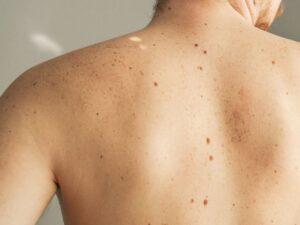Symptoms of Skin Cancer
Skin cancer can manifest through various symptoms. Watch out for any changes in moles or growths, such as asymmetry, irregular borders, colour variations, or an increase in size. Pay attention to new or persistent sores that don’t heal, itching, bleeding, or scaly patches. If you notice any of these symptoms, it’s essential to consult a healthcare professional promptly for an accurate diagnosis and appropriate treatment. Early detection is key for effective management of skin cancer.
Types of Skin Cancer
There are many types of skin cancer. The three common ones are;
Squamous Cell Carcinoma
This presents as a firm irregular fleshy growth usually on sun-exposed skin. The growth can increase rapidly, giving rise to a large lump which may sometimes break down to form an ulcer. If untreated, the cancer may spread to the surrounding lymph glands. Squamous Cell Carcinoma usually appears in elderly patients. Chronic sun exposure is an important contributing factor in the development of this type of skin cancer.
Basal Cell Carcinoma
This is a slow-growing painless skin cancer. The cancer often presents as an indolent ulcer with a shiny or translucent raised margin. The ulcer is usually pigmented. This cancer commonly appears on the face.
Malignant Melanoma
This is a cancer of the pigment cells of the skin. It is a highly malignant skin cancer. It presents as dark brown or black skin growth or ulcer. It may look like ordinary moles. But unlike the common mole:-
- It grows rapidly
- Its surface has several shades of red, black or blue colours
- Its margin is irregular
- It tends to be large.
- It tends to be thick.
Melanoma is uncommon among Asians. Melanoma commonly occurs on the fingers, toes and face.

Treatment for skin cancers at Venkat Center
All skin cancers should be removed immediately. The cancerous tumours must be destroyed or removed surgically. Sometimes, a small piece of the tumour is removed (skin biopsy) first for examination to confirm if it is cancerous.
At Venkat Center, we offer a range of effective treatments for various types of skin cancer. Our experienced team specializes in diagnosing and treating basal cell carcinoma, squamous cell carcinoma, and melanoma. With advanced techniques such as surgical excision, Mohs surgery, cryotherapy, and topical therapies, we aim to provide personalized care and successful outcomes. Trust us for comprehensive skin cancer treatments tailored to your specific needs.
What are the pre-malignant tumours?
Congenital moles
These are moles that are present at birth. Such moles vary in size. They are usually present on the trunk. These congenital moles may develop into cancers (melanoma). Therefore, they should be removed whenever possible. The larger the congenital mole, the higher the risk of cancer developing later on. Congenital naevi may be associated with other malformations.
Actinic keratosis
These lesions are seen on sun-exposed skin, especially on the face, upper chest, back and forearms. They appear as scaly reddish or brown patches on the skin. Numerous lesions may occur at the same time. If left untreated, they can go on to develop into skin cancers.
Treatment of Pre-malignant growths
These can easily be destroyed using liquid nitrogen (like dry ice) or anti-cancer ointments or electrosurgery or excision surgery or laser surgery. If you have a skin tumour, it is advisable to check it out with your doctor. He can then advise you on the diagnosis and action to be taken.



